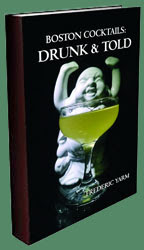To get up to speed on the other experiments, please read:I realized that the thermal effects of the glass on the drink (experiment 1) were worth revisiting using different types of glasses. Therefore, I selected one cocktail glass type that was thinner and and fragile than the Libbey Martini glasses and one type that was thicker and more clunk clunky. Despite weighing the glasses, I have to assume that there is only a percentage of that mass (albeit a large fraction) that is effective in the temperature transfer in the short term and that the thermal contribution in the stem and base were less important. But what about a rocks or Old Fashioned glass? With no stem and often a rather thick base, how would this compare to cocktail glasses? Instead of looking at the rates of chilling of the various glassware, I chose to investigate how each of the glass types behaved on a shaker-chilled drink when the glasses were either room temperature or cooled in the freezer.
• Part 1: Effects of Glass Temperature
• Part 2: Kinetics of Glass Cooling
Materials:
• 21 oz Vesica Vodka (80 proof)
• 2 Thin Cocktail Glasses
• 2 Thick Cocktail Glasses
• 2 Double Old Fashioned Glasses
• Freezer
• Cobbler Shaker
• Fine Strainer
• OXO Measuring Cup
• Ice from Tovolo Trays from Freezer
• Digital Thermometer with Thermocouple (-58°F to 2372°F, ±0.1°F)
• Timer Application on Droid Phone
• Digital Scale

(l-r: thin cocktail, thick cocktail, double Old Fashioned)
Protocol:
• Measure room temperature and freezer temperature.
• Weigh each of the glasses.
• Chill one glass of each type in freezer until fully chilled (2.5 hours).
• Keep one glass of each type at room temperature.
• Add 3 oz vodka and 4 ice cubes to cobbler shaker. Shake 30 seconds.
• Double strain to remove ice shards.
• Measure temperature every 30 seconds for 5 minutes while gently stirring with temperature probe.
• Glasses removed from freezer 10 seconds before straining.
• Do a round of shaking to measure initial temperature before straining.
Caveats:
• See previous experiments for rationales on shaking a Vodka "Martini." Also read the rationale for only measuring the initial temperature in the shaker (t=0) once on a separate experiment.
• Room, ice, and freezer temperatures will affect results.
• Different drink compositions will change the amount of alcohol, sugar, and other solutes in the drink and may effect temperatures.
• Experiment was only performed once per condition instead of triplicate like the first experiment. The time courses of the replicates did not show significant variation then to warrant the extra spirit and time expenditure.
Data:
• Room Temperature: 67.4°F
• Freezer Temperature: 3.9°F
• Vodka (shaken for 30 seconds) Temperature: 23.7°F
• Glass Weights (for room temperature and freezer conditions):
Thin Glass: RT 112.5 grams, Fr 112.5 grams
Thick Glass: RT 159.1 grams, Fr 166.7 grams
Double OF: RT 375.5 grams, Fr 382.7 grams

Conclusions:
When glasses were not chilled, the thickness or mass of the glasses' material in contact with the drink correlated with the degree of warmth it imparted to the cooled drink. It makes sense that the warmer and thicker the glass, the more it will affect the drink, but by how much and over what time frame? This effect was both instantaneous such as the ~2 degree range (for the 3 glasses) in the drink at 60 seconds to ~5 degree range at 5 minutes. Indeed, the linear parts of the curve have different slopes suggesting that thicker glasses will take much longer to come into equilibrium with the drink.
When the glasses were chilled in the freezer, an interesting situation occurred. For the two thicker glasses, the drink was actually chilled further after shaking. While the drink in the thinnest glass immediately started warming up by the first time point of 30 seconds, the drink in the middle thickness glass dropped to a lower temperature at 30 and 60 seconds, returned to close to the shaken temperature at 90 seconds, and started increasing at the 120 seconds time point. The double Old Fashioned was even more extreme; the temperature of the drink kept dropping until about 150 seconds. Even after the 5 minute time point, the drink from the freezer-chilled double Old Fashioned glass was even colder than it was when first shaken.
This superchilling effect would most likely not be observed in the ice water-chilled glasses for the theoretical temperature of 32°F (experimentally 33.6-33.9°F in the first two experiments) for ice water is warmer than the temperature of the shaken drink (here, 23.7°F). On the other hand, the ice water chilling would still decrease the rates that the drink warmed up from the initial temperature upon shaking. Here, I did not attempt the ice water-chilled condition with the different glass types to keep the experiment as simple as possible; however, in retrospect, they would have been interesting data points.
In summary, the choice of glassware does matter greatly. The obvious take home message is that thinner glasses are better when the only option is unchilled glassware, but when freezer chilled, thinner glasses impart less potent cooling effects. The thicker the glass, the need to chill the glassware before use becomes more grave. What was less obvious was that freezer-chilled glassware can actually help to drop the drink's temperature even further than the temperature in the shaker. The first experiment missed that effect for the Libbey Martini glasses, while not fragile, were not thick enough to observe this negative temperature effect. Lastly, this experiment does not address the extra time it would take to chill a thicker glass with either ice water or freezer storage.
 The 2017 collection of 855 drink recipes, bartender tributes, and essays on hospitality from CocktailVirgin's Frederic Yarm. Available at
The 2017 collection of 855 drink recipes, bartender tributes, and essays on hospitality from CocktailVirgin's Frederic Yarm. Available at  The 2012 collection of 505 drink recipes, techniques, and Boston bar recommendations from Frederic Yarm. Available at
The 2012 collection of 505 drink recipes, techniques, and Boston bar recommendations from Frederic Yarm. Available at 




4 comments:
I really enjoy this series of posts!
Great job.
Oh, btw, remind me of getting you a thermometer in Celsius next time we meet. Just kidding… :)
Another interesting variable to think about is the shape of the glassware. Given a certain volume, the surface area of glass that is in contact with the liquid will be different. Take glassware to be easy geometric shapes: cone (cocktail glass), cylinder (old fashioned glass), semi-sphere (coupe). At dimensions that may be expected for such glassware, the cylinder will have the largest surface area of liquid exposed to glass, followed by the cone and semi-sphere last Assuming that the glasses are stored in the freezer and are consequently colder than the liquid initially, then one might expect the glass with the most surface area to continue to cool more effectively. Additionally, if you consider the surface area of glass exposed to air that warms the drink, then I think the cone shaped glass should warm faster than a semi-spherical glass of equal mass. By similar logic, I would expect a champagne flute, modeled as a tall and thin cylinder, to warm the fastest. The stemlessness of the old-fashioned glass means that the surface area is nearly half that of the cocktail glass.
Tony, my thermometer does Celsius, Fahrenheit, and Kelvin, and I'm as comfortable with °C as I am with °F. However, most of my readership is not (one way or the other).
Ryan, I did think of the effect of surface area on temperature exchange, but analyzing my glassware to place it on a surface area to mass array was not trivial. Especially if I wanted the weights of the glasses (or the glasses' bowls) to all be similar.
Also, I am assuming that the warming from the air is a lot slower (similar to in experiment 2 how the ice water (liquid) transferred energy to the glass a lot faster than the freezer (air) despite the freezer air being much cooler.
Once again, nicely done. Way to pick up my implied gauntlet, and quickly and thoroughly at that.
Post a Comment